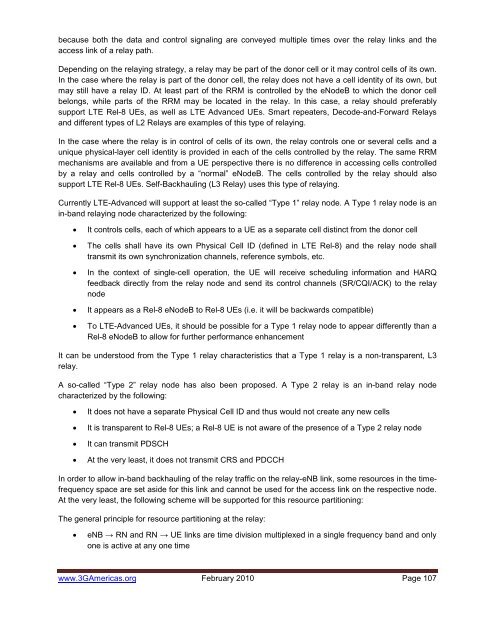UMTS: Alive and Well - 4G Americas
UMTS: Alive and Well - 4G Americas
UMTS: Alive and Well - 4G Americas
You also want an ePaper? Increase the reach of your titles
YUMPU automatically turns print PDFs into web optimized ePapers that Google loves.
ecause both the data <strong>and</strong> control signaling are conveyed multiple times over the relay links <strong>and</strong> theaccess link of a relay path.Depending on the relaying strategy, a relay may be part of the donor cell or it may control cells of its own.In the case where the relay is part of the donor cell, the relay does not have a cell identity of its own, butmay still have a relay ID. At least part of the RRM is controlled by the eNodeB to which the donor cellbelongs, while parts of the RRM may be located in the relay. In this case, a relay should preferablysupport LTE Rel-8 UEs, as well as LTE Advanced UEs. Smart repeaters, Decode-<strong>and</strong>-Forward Relays<strong>and</strong> different types of L2 Relays are examples of this type of relaying.In the case where the relay is in control of cells of its own, the relay controls one or several cells <strong>and</strong> aunique physical-layer cell identity is provided in each of the cells controlled by the relay. The same RRMmechanisms are available <strong>and</strong> from a UE perspective there is no difference in accessing cells controlledby a relay <strong>and</strong> cells controlled by a “normal” eNodeB. The cells controlled by the relay should alsosupport LTE Rel-8 UEs. Self-Backhauling (L3 Relay) uses this type of relaying.Currently LTE-Advanced will support at least the so-called “Type 1” relay node. A Type 1 relay node is anin-b<strong>and</strong> relaying node characterized by the following:• It controls cells, each of which appears to a UE as a separate cell distinct from the donor cell• The cells shall have its own Physical Cell ID (defined in LTE Rel-8) <strong>and</strong> the relay node shalltransmit its own synchronization channels, reference symbols, etc.• In the context of single-cell operation, the UE will receive scheduling information <strong>and</strong> HARQfeedback directly from the relay node <strong>and</strong> send its control channels (SR/CQI/ACK) to the relaynode• It appears as a Rel-8 eNodeB to Rel-8 UEs (i.e. it will be backwards compatible)• To LTE-Advanced UEs, it should be possible for a Type 1 relay node to appear differently than aRel-8 eNodeB to allow for further performance enhancementIt can be understood from the Type 1 relay characteristics that a Type 1 relay is a non-transparent, L3relay.A so-called “Type 2” relay node has also been proposed. A Type 2 relay is an in-b<strong>and</strong> relay nodecharacterized by the following:• It does not have a separate Physical Cell ID <strong>and</strong> thus would not create any new cells• It is transparent to Rel-8 UEs; a Rel-8 UE is not aware of the presence of a Type 2 relay node• It can transmit PDSCH• At the very least, it does not transmit CRS <strong>and</strong> PDCCHIn order to allow in-b<strong>and</strong> backhauling of the relay traffic on the relay-eNB link, some resources in the timefrequencyspace are set aside for this link <strong>and</strong> cannot be used for the access link on the respective node.At the very least, the following scheme will be supported for this resource partitioning:The general principle for resource partitioning at the relay:• eNB → RN <strong>and</strong> RN → UE links are time division multiplexed in a single frequency b<strong>and</strong> <strong>and</strong> onlyone is active at any one timewww.3G<strong>Americas</strong>.org February 2010 Page 107
















